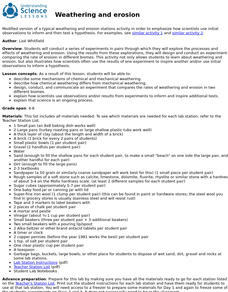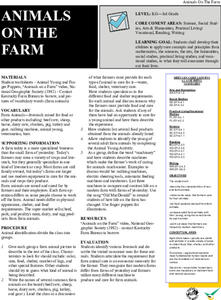Agriculture in the Classroom
A Rafter of Turkeys
How did that turkey get from the early Aztec culture to your table? Learn about the history of wild and domesticated turkeys in North America, as well as their inclusion in Thanksgiving traditions, with a two-part agricultural science...
Curated OER
The Turkey Web
Students identify habitat and feeding habits of the wild turkey. In habitat and diet instructional activity students view a demonstration, complete an activity then follow turkey sign.
Curated OER
Turkeys in the Cell--The Meiosis Square Dance
Learners identify synapsis as the key event in meiosis. They explain how synapsis leads to the formation of haploid gametes. Exploration of the differences between the processes of mitosis and meiosis occur. In accordance, explanations...
Baylor College
Digestion
Digestion is an amazing and complicated process that provides humans with the energy they need to survive. Lesson six in this series on the science of food uses sliced turkey and a meat tenderizer to demonstrate how enzymes help break...
Curated OER
Turkeys in the Cell -- The Meiosis Square Dance
Students identify the differences between the processes of mitosis and meiosis and explain how meiosis generates new combinations for natural selection. They illustrate the processes by square dancing.
California Academy of Science
Using Empirical Data in the Classroom: Raptor Migrations!
Raptor flight patterns align with seasonal changes in net primary productivity. Here is a thought-provoking lesson plan that uses empirical data from a video to help scholars understand raptor migrations, producers/consumers, and...
Curated OER
What Can We Learn from Artifacts?
Students examine how artifacts are discovered and explore their significance as it pertains to gathering important information. In this artifacts lesson, students obtain knowledge about the way artifacts are excavated and examine an...
Curated OER
Agriculture: Oklahoma's Legacy
Sixth graders explore agriculture as it relates to crops over the course of a series of historical events. They read and create a timeline of the 50-year increments that depict important cause and effect events. Students then use...
Curated OER
Who Am I? Species of Birds
In this science worksheet, learners examine 16 detailed pictures of birds. Students identify each bird and write the name on the line. Answers are given upside down at the bottom of the page.
Curated OER
Food For Energy - Four Food Groups
Students consider how food is converted to energy. For this science lesson plan, students explore the importance of eating properly with a balanced diet as they study 4 food groups.
Curated OER
Matters of Milk and Marshmallows
Students observe a teacher demonstration o classifying matter by its physical properties of shape and size. After discussing the definition of matter, students describe the state of matter. They sing a song to the tune of "Bingo." In...
Curated OER
Kindergarteners Study the Four Seasons
Examine the weather of the four seasons, look at seasonal activities, and tell which months are part of each season with this lesson plan. Your class will play a game, sing a song, and write additional stanzas to seasonal poetry.
Hubbard's Cupboard
The Pilgrims' First Thanksgiving
Students explore holidays by participating in class singing activities. In this Thanksgiving history lesson, students discuss the importance of Thanksgiving Day and read several poems which discuss the history of Thanksgiving. Students...
Curated OER
Using Science Skills to Investigate Japanese Quail
Sixth graders explore Japanese Quail. They generate and record scientific questions about the quail. Students gather information from various sources and record their data. They compose an inquiry report and include it in a portfolio.
Education World
Thinking About Thanksgiving: Lessons Across the Curriculum
Bring two integrated curriculum resources about Thanksgiving to an elementary social studies unit. The first activity focuses on Squanto's contributions to the early Pilgrims' survival with a gardening activity in which learners add...
Scholastic
Drones Take Off
Ever wonder what drones are doing high above us in the sky? This article gives your class an insight to what those robots in the sky are doing. After reading an article on drone technology, pupils are prompted to respond to a...
University of California
Weathering and Erosion
Just how powerful is erosion? Interested scientists learn how to identify the results of erosion with a series of lab activities. They move through stations to experiment with different types of erosion and then design and complete their...
Curated OER
Managing Wildlife
Students discuss the current conditions of wildlife in New England. Students explore how animals are tracked and how their population is managed.
Curated OER
DIY Lava Lamp
Students examine lava lamps and what causes them to work. In this density lesson students make a lava lamp and write the scientific explanation of what happens.
Curated OER
A Pox No Longer Upon Us
Tenth graders research the development and use of vaccines. They examine historical documents for qualitative observations and the basis of immunization. They examine primary and secondary immune responses as they relate to the...
Curated OER
Growing and Harvesting Fruits and Vegetables
Students learn the various parts of a farm and what is grown on a farm. They also match fruits and vegetables to locations where they are grown.
Curated OER
Animals on the Farm
Students work in groups to create a description of a farm animal. Other classmates try to guess the animal. The class discusses what farmers need to provide for each animal on their farm (food, shelter, veterinary care). Students...
Curated OER
A Perfect Pond Study Lesson Plan
Students take a field trip to a wetland ecosystem. An informal pond study is performed by students. They examine their favorite animal, write a description of how it moves and illustrate it. In groups, students draw pictures of organisms...
Curated OER
Variations in Growth and Reproduction of Recently Transplanted Prairie Forbes and Grasses
students recognize and name prairie plants without the use of a key. they determine that prairie plants have different life cycles that affect their rate of growth and reproduction























